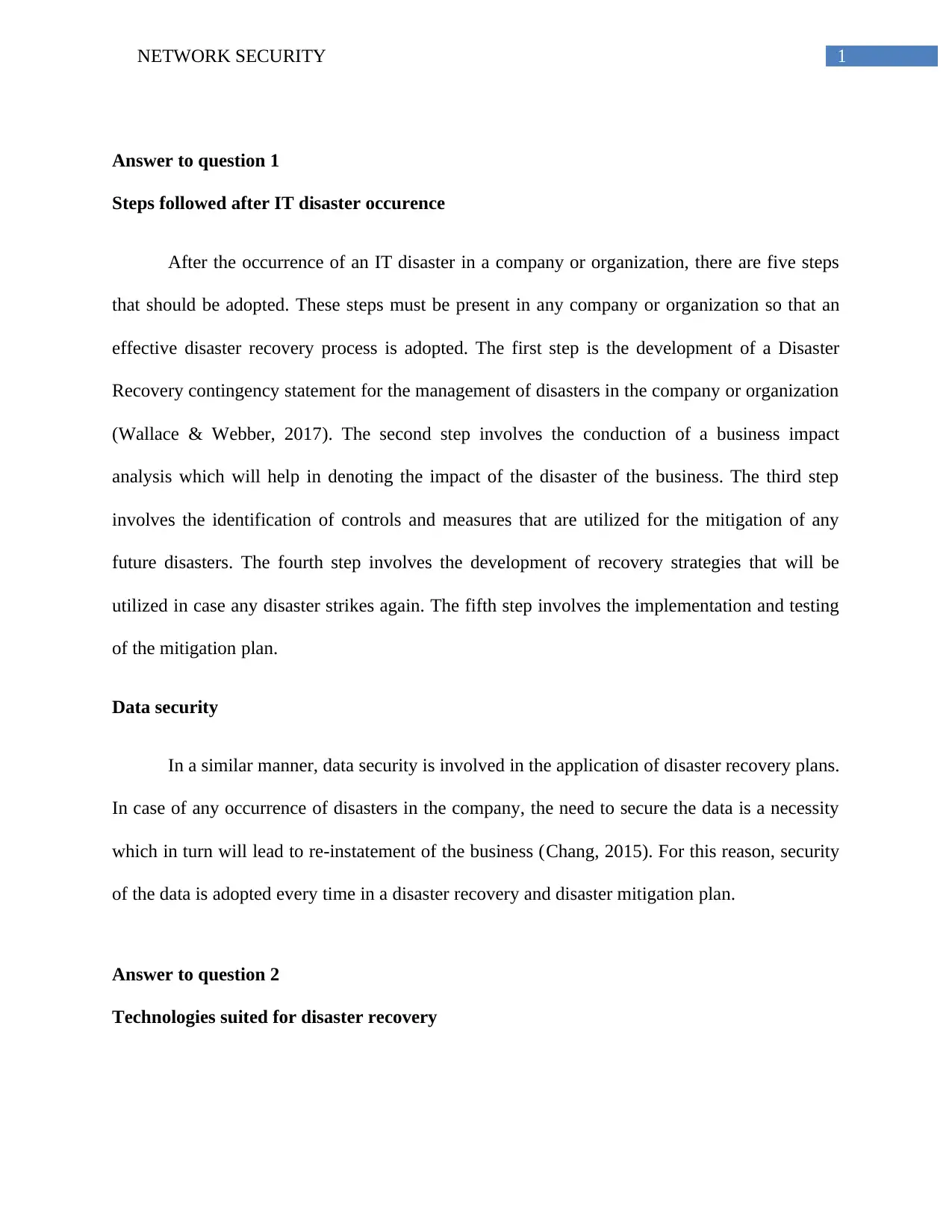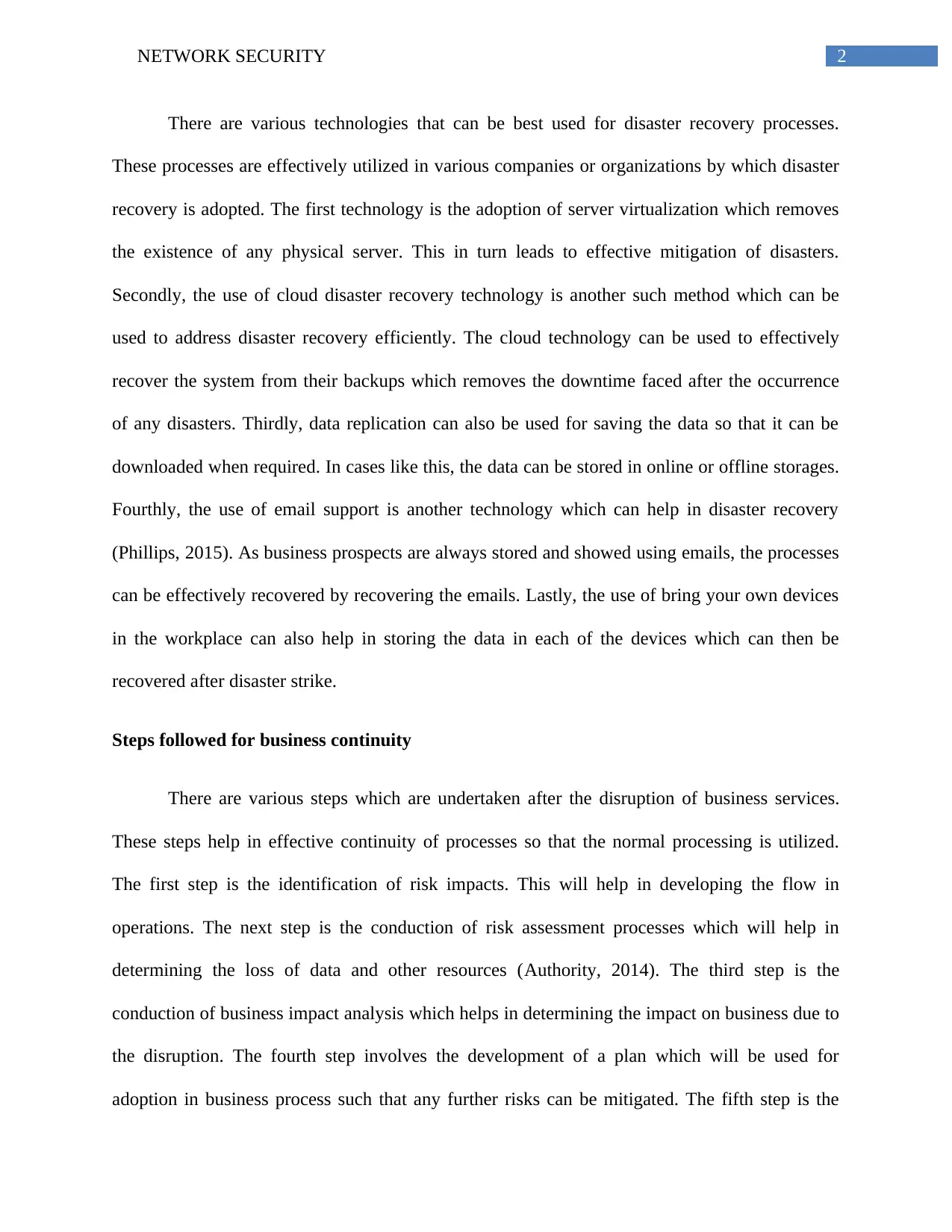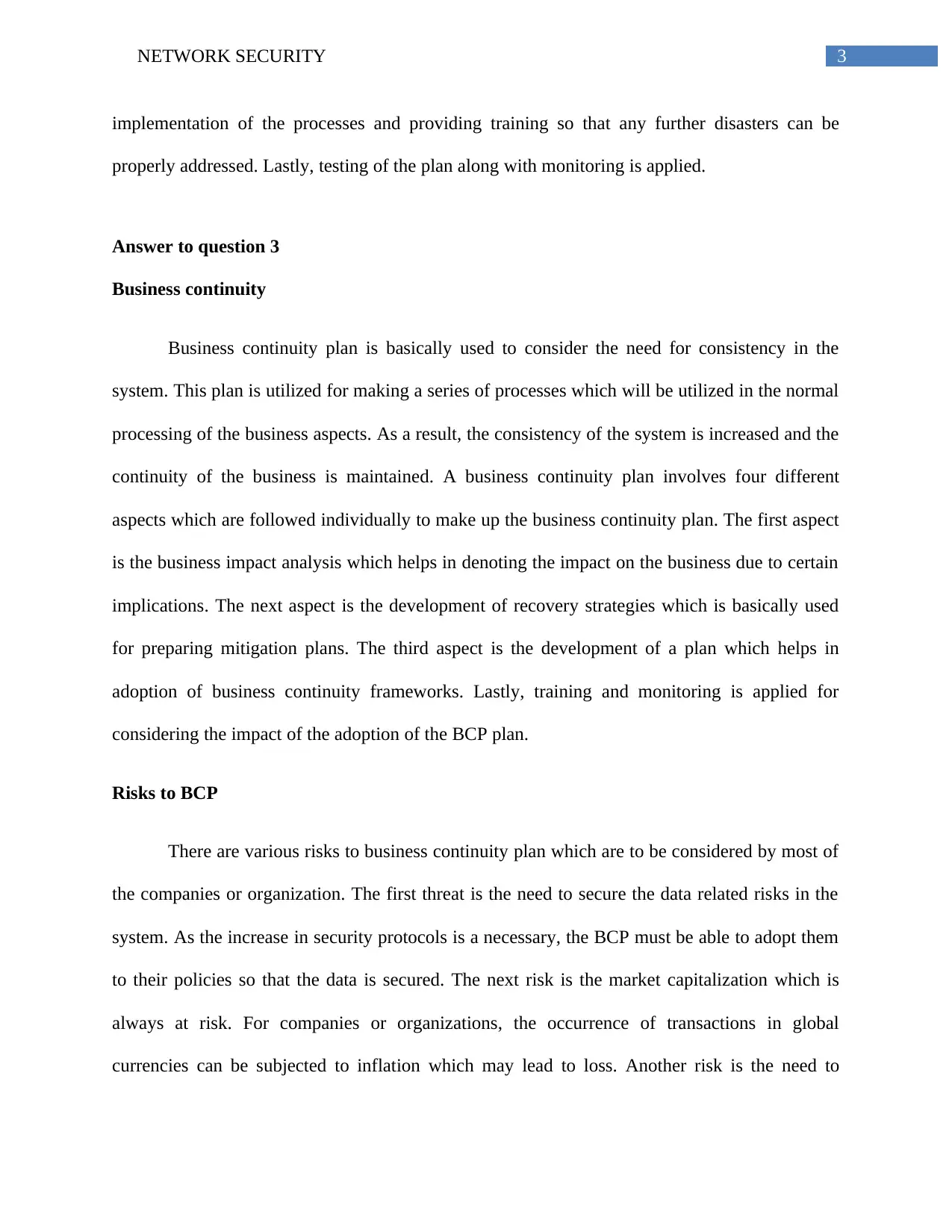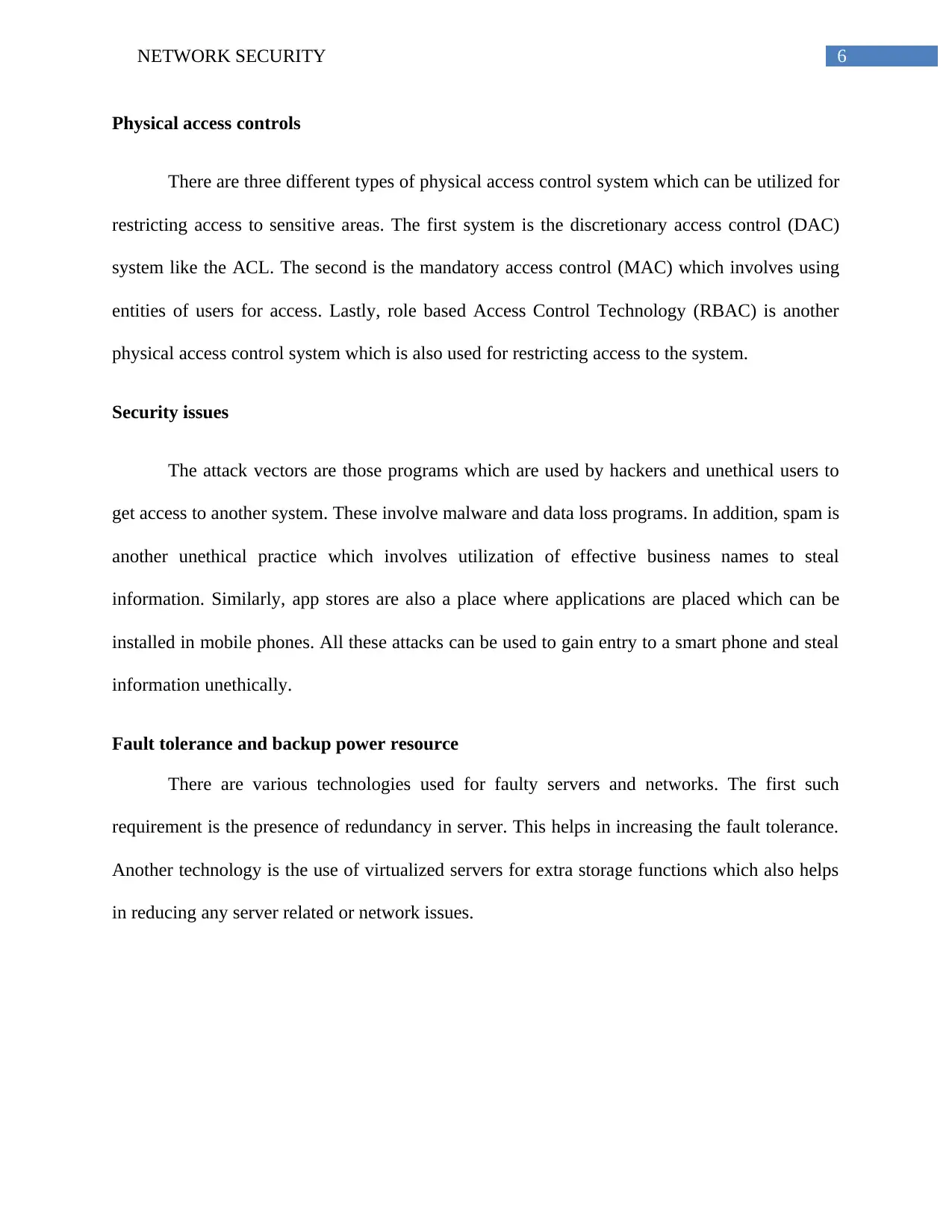Network Security: Disaster Recovery, Business Continuity & Policies
VerifiedAdded on 2023/06/15
|8
|1971
|398
Report
AI Summary
This report provides a comprehensive overview of network security, focusing on disaster recovery and business continuity. It details the steps to be taken after an IT disaster, including developing a disaster recovery contingency statement, conducting a business impact analysis, identifying mitigation controls, developing recovery strategies, and implementing a mitigation plan. The report also discusses technologies suited for disaster recovery, such as server virtualization, cloud disaster recovery, data replication, email support, and bring your own devices (BYOD). Furthermore, it outlines the steps for business continuity, the risks to business continuity plans (BCP), and the key steps in developing an incident response policy. The document also explores the uses of digital signatures in corporate dealings, the role of cryptography in internet security, and the processes of encryption and decryption. Finally, it discusses technologies for disaster recovery security, physical access controls, common security issues like malware and spam, and fault tolerance and backup power resources. Desklib provides access to this and other solved assignments to aid students.

Running head: NETWORK SECURITY
Network security
Name of the student
Name of the University
Author note
Network security
Name of the student
Name of the University
Author note
Paraphrase This Document
Need a fresh take? Get an instant paraphrase of this document with our AI Paraphraser

1NETWORK SECURITY
Answer to question 1
Steps followed after IT disaster occurence
After the occurrence of an IT disaster in a company or organization, there are five steps
that should be adopted. These steps must be present in any company or organization so that an
effective disaster recovery process is adopted. The first step is the development of a Disaster
Recovery contingency statement for the management of disasters in the company or organization
(Wallace & Webber, 2017). The second step involves the conduction of a business impact
analysis which will help in denoting the impact of the disaster of the business. The third step
involves the identification of controls and measures that are utilized for the mitigation of any
future disasters. The fourth step involves the development of recovery strategies that will be
utilized in case any disaster strikes again. The fifth step involves the implementation and testing
of the mitigation plan.
Data security
In a similar manner, data security is involved in the application of disaster recovery plans.
In case of any occurrence of disasters in the company, the need to secure the data is a necessity
which in turn will lead to re-instatement of the business (Chang, 2015). For this reason, security
of the data is adopted every time in a disaster recovery and disaster mitigation plan.
Answer to question 2
Technologies suited for disaster recovery
Answer to question 1
Steps followed after IT disaster occurence
After the occurrence of an IT disaster in a company or organization, there are five steps
that should be adopted. These steps must be present in any company or organization so that an
effective disaster recovery process is adopted. The first step is the development of a Disaster
Recovery contingency statement for the management of disasters in the company or organization
(Wallace & Webber, 2017). The second step involves the conduction of a business impact
analysis which will help in denoting the impact of the disaster of the business. The third step
involves the identification of controls and measures that are utilized for the mitigation of any
future disasters. The fourth step involves the development of recovery strategies that will be
utilized in case any disaster strikes again. The fifth step involves the implementation and testing
of the mitigation plan.
Data security
In a similar manner, data security is involved in the application of disaster recovery plans.
In case of any occurrence of disasters in the company, the need to secure the data is a necessity
which in turn will lead to re-instatement of the business (Chang, 2015). For this reason, security
of the data is adopted every time in a disaster recovery and disaster mitigation plan.
Answer to question 2
Technologies suited for disaster recovery

2NETWORK SECURITY
There are various technologies that can be best used for disaster recovery processes.
These processes are effectively utilized in various companies or organizations by which disaster
recovery is adopted. The first technology is the adoption of server virtualization which removes
the existence of any physical server. This in turn leads to effective mitigation of disasters.
Secondly, the use of cloud disaster recovery technology is another such method which can be
used to address disaster recovery efficiently. The cloud technology can be used to effectively
recover the system from their backups which removes the downtime faced after the occurrence
of any disasters. Thirdly, data replication can also be used for saving the data so that it can be
downloaded when required. In cases like this, the data can be stored in online or offline storages.
Fourthly, the use of email support is another technology which can help in disaster recovery
(Phillips, 2015). As business prospects are always stored and showed using emails, the processes
can be effectively recovered by recovering the emails. Lastly, the use of bring your own devices
in the workplace can also help in storing the data in each of the devices which can then be
recovered after disaster strike.
Steps followed for business continuity
There are various steps which are undertaken after the disruption of business services.
These steps help in effective continuity of processes so that the normal processing is utilized.
The first step is the identification of risk impacts. This will help in developing the flow in
operations. The next step is the conduction of risk assessment processes which will help in
determining the loss of data and other resources (Authority, 2014). The third step is the
conduction of business impact analysis which helps in determining the impact on business due to
the disruption. The fourth step involves the development of a plan which will be used for
adoption in business process such that any further risks can be mitigated. The fifth step is the
There are various technologies that can be best used for disaster recovery processes.
These processes are effectively utilized in various companies or organizations by which disaster
recovery is adopted. The first technology is the adoption of server virtualization which removes
the existence of any physical server. This in turn leads to effective mitigation of disasters.
Secondly, the use of cloud disaster recovery technology is another such method which can be
used to address disaster recovery efficiently. The cloud technology can be used to effectively
recover the system from their backups which removes the downtime faced after the occurrence
of any disasters. Thirdly, data replication can also be used for saving the data so that it can be
downloaded when required. In cases like this, the data can be stored in online or offline storages.
Fourthly, the use of email support is another technology which can help in disaster recovery
(Phillips, 2015). As business prospects are always stored and showed using emails, the processes
can be effectively recovered by recovering the emails. Lastly, the use of bring your own devices
in the workplace can also help in storing the data in each of the devices which can then be
recovered after disaster strike.
Steps followed for business continuity
There are various steps which are undertaken after the disruption of business services.
These steps help in effective continuity of processes so that the normal processing is utilized.
The first step is the identification of risk impacts. This will help in developing the flow in
operations. The next step is the conduction of risk assessment processes which will help in
determining the loss of data and other resources (Authority, 2014). The third step is the
conduction of business impact analysis which helps in determining the impact on business due to
the disruption. The fourth step involves the development of a plan which will be used for
adoption in business process such that any further risks can be mitigated. The fifth step is the
⊘ This is a preview!⊘
Do you want full access?
Subscribe today to unlock all pages.

Trusted by 1+ million students worldwide

3NETWORK SECURITY
implementation of the processes and providing training so that any further disasters can be
properly addressed. Lastly, testing of the plan along with monitoring is applied.
Answer to question 3
Business continuity
Business continuity plan is basically used to consider the need for consistency in the
system. This plan is utilized for making a series of processes which will be utilized in the normal
processing of the business aspects. As a result, the consistency of the system is increased and the
continuity of the business is maintained. A business continuity plan involves four different
aspects which are followed individually to make up the business continuity plan. The first aspect
is the business impact analysis which helps in denoting the impact on the business due to certain
implications. The next aspect is the development of recovery strategies which is basically used
for preparing mitigation plans. The third aspect is the development of a plan which helps in
adoption of business continuity frameworks. Lastly, training and monitoring is applied for
considering the impact of the adoption of the BCP plan.
Risks to BCP
There are various risks to business continuity plan which are to be considered by most of
the companies or organization. The first threat is the need to secure the data related risks in the
system. As the increase in security protocols is a necessary, the BCP must be able to adopt them
to their policies so that the data is secured. The next risk is the market capitalization which is
always at risk. For companies or organizations, the occurrence of transactions in global
currencies can be subjected to inflation which may lead to loss. Another risk is the need to
implementation of the processes and providing training so that any further disasters can be
properly addressed. Lastly, testing of the plan along with monitoring is applied.
Answer to question 3
Business continuity
Business continuity plan is basically used to consider the need for consistency in the
system. This plan is utilized for making a series of processes which will be utilized in the normal
processing of the business aspects. As a result, the consistency of the system is increased and the
continuity of the business is maintained. A business continuity plan involves four different
aspects which are followed individually to make up the business continuity plan. The first aspect
is the business impact analysis which helps in denoting the impact on the business due to certain
implications. The next aspect is the development of recovery strategies which is basically used
for preparing mitigation plans. The third aspect is the development of a plan which helps in
adoption of business continuity frameworks. Lastly, training and monitoring is applied for
considering the impact of the adoption of the BCP plan.
Risks to BCP
There are various risks to business continuity plan which are to be considered by most of
the companies or organization. The first threat is the need to secure the data related risks in the
system. As the increase in security protocols is a necessary, the BCP must be able to adopt them
to their policies so that the data is secured. The next risk is the market capitalization which is
always at risk. For companies or organizations, the occurrence of transactions in global
currencies can be subjected to inflation which may lead to loss. Another risk is the need to
Paraphrase This Document
Need a fresh take? Get an instant paraphrase of this document with our AI Paraphraser

4NETWORK SECURITY
consider the longer supply chains in production. In case of supply chain extension, the need to
consider the working and middle classes are necessary.
Incident response policy
There are seven steps to be followed for making the incidence response policy. The bank
of Auckland must consider the seven steps for incident policy development. The first step is the
preparation of the policy which involves preparing the plan. The next step is the identification of
the problems which will be addressed. The next step is the identification step which involves
identification of the disaster (Pillai et al., 2014). The third step is the containment which involves
containing the situation such that extended problems are not noted. The fourth method is
investigation which involves investigating the source of the problem such that any further
occurrence is mitigated. The fifth method involves eradication so that proper steps are followed.
The next method involves recovery which is involved with recovering from the situation. Lastly,
the follow-up step is involved with monitoring of the system.
Answer to question 4
There are various uses of digital signatures which help in corporate dealings and
activities. In case of an employee, transferring of signatures via email can help in better
addressing of document transfer. This removes the need for problems. Similarly, in case of
corporate personnel, the transfer of singed documents becomes very easy.
Answer to question 5
Cryptography
consider the longer supply chains in production. In case of supply chain extension, the need to
consider the working and middle classes are necessary.
Incident response policy
There are seven steps to be followed for making the incidence response policy. The bank
of Auckland must consider the seven steps for incident policy development. The first step is the
preparation of the policy which involves preparing the plan. The next step is the identification of
the problems which will be addressed. The next step is the identification step which involves
identification of the disaster (Pillai et al., 2014). The third step is the containment which involves
containing the situation such that extended problems are not noted. The fourth method is
investigation which involves investigating the source of the problem such that any further
occurrence is mitigated. The fifth method involves eradication so that proper steps are followed.
The next method involves recovery which is involved with recovering from the situation. Lastly,
the follow-up step is involved with monitoring of the system.
Answer to question 4
There are various uses of digital signatures which help in corporate dealings and
activities. In case of an employee, transferring of signatures via email can help in better
addressing of document transfer. This removes the need for problems. Similarly, in case of
corporate personnel, the transfer of singed documents becomes very easy.
Answer to question 5
Cryptography

5NETWORK SECURITY
For accessing the internet, the use of cryptography mainly helps in increasing the security
of the system. This is mainly done by the adoption of encryption methodologies. For accessing
the internet, the need for encryption is a requirement. This helps in securing the credentials of the
user which in turn lead to peace of mind. For example, the HTTPS connections of a website are
mainly done by utilizing cryptography for making websites secure.
Encryption and Decryption
The steps involved in the encryption and decryption of the system involves ciphering the
texts. This involves five different steps which involves encryption and decryption. The first step
involves is the creation of a cipher text. This involves making a coded message which can only
be decoded by the receiver. The next step is the development of shared key. This key is used to
decode the original text from the ciphered text. The next step is using the key for decrypting the
ciphered text. This can only be done by using the key received from the sender. Lastly, the
message is read and the corresponding output is given to the sender to acknowledge their
message transfer.
Technologies suited for disaster recovery security
There are various technologies that can be best used for disaster recovery processes. The
first technology is the adoption of server virtualization which helps to removes the existence of
physical servers. Secondly, the use of cloud recovery is another such method which can be used
to address disaster recovery. Thirdly, data replication can also be used for saving the data so that
it can be loaded when required. Fourthly, the use of email support can help in disaster recovery.
Lastly, the use of bring your own devices in the workplace can also help in storing the data in
each of the devices.
For accessing the internet, the use of cryptography mainly helps in increasing the security
of the system. This is mainly done by the adoption of encryption methodologies. For accessing
the internet, the need for encryption is a requirement. This helps in securing the credentials of the
user which in turn lead to peace of mind. For example, the HTTPS connections of a website are
mainly done by utilizing cryptography for making websites secure.
Encryption and Decryption
The steps involved in the encryption and decryption of the system involves ciphering the
texts. This involves five different steps which involves encryption and decryption. The first step
involves is the creation of a cipher text. This involves making a coded message which can only
be decoded by the receiver. The next step is the development of shared key. This key is used to
decode the original text from the ciphered text. The next step is using the key for decrypting the
ciphered text. This can only be done by using the key received from the sender. Lastly, the
message is read and the corresponding output is given to the sender to acknowledge their
message transfer.
Technologies suited for disaster recovery security
There are various technologies that can be best used for disaster recovery processes. The
first technology is the adoption of server virtualization which helps to removes the existence of
physical servers. Secondly, the use of cloud recovery is another such method which can be used
to address disaster recovery. Thirdly, data replication can also be used for saving the data so that
it can be loaded when required. Fourthly, the use of email support can help in disaster recovery.
Lastly, the use of bring your own devices in the workplace can also help in storing the data in
each of the devices.
⊘ This is a preview!⊘
Do you want full access?
Subscribe today to unlock all pages.

Trusted by 1+ million students worldwide

6NETWORK SECURITY
Physical access controls
There are three different types of physical access control system which can be utilized for
restricting access to sensitive areas. The first system is the discretionary access control (DAC)
system like the ACL. The second is the mandatory access control (MAC) which involves using
entities of users for access. Lastly, role based Access Control Technology (RBAC) is another
physical access control system which is also used for restricting access to the system.
Security issues
The attack vectors are those programs which are used by hackers and unethical users to
get access to another system. These involve malware and data loss programs. In addition, spam is
another unethical practice which involves utilization of effective business names to steal
information. Similarly, app stores are also a place where applications are placed which can be
installed in mobile phones. All these attacks can be used to gain entry to a smart phone and steal
information unethically.
Fault tolerance and backup power resource
There are various technologies used for faulty servers and networks. The first such
requirement is the presence of redundancy in server. This helps in increasing the fault tolerance.
Another technology is the use of virtualized servers for extra storage functions which also helps
in reducing any server related or network issues.
Physical access controls
There are three different types of physical access control system which can be utilized for
restricting access to sensitive areas. The first system is the discretionary access control (DAC)
system like the ACL. The second is the mandatory access control (MAC) which involves using
entities of users for access. Lastly, role based Access Control Technology (RBAC) is another
physical access control system which is also used for restricting access to the system.
Security issues
The attack vectors are those programs which are used by hackers and unethical users to
get access to another system. These involve malware and data loss programs. In addition, spam is
another unethical practice which involves utilization of effective business names to steal
information. Similarly, app stores are also a place where applications are placed which can be
installed in mobile phones. All these attacks can be used to gain entry to a smart phone and steal
information unethically.
Fault tolerance and backup power resource
There are various technologies used for faulty servers and networks. The first such
requirement is the presence of redundancy in server. This helps in increasing the fault tolerance.
Another technology is the use of virtualized servers for extra storage functions which also helps
in reducing any server related or network issues.
Paraphrase This Document
Need a fresh take? Get an instant paraphrase of this document with our AI Paraphraser

7NETWORK SECURITY
References
Authority, C. A. S. (2014). Business Continuity Management.
Chang, V. (2015). Towards a Big Data system disaster recovery in a Private Cloud. Ad Hoc
Networks, 35, 65-82.
Kizza, J. M. (2017). Guide to computer network security. Springer.
Perlman, R., Kaufman, C., & Speciner, M. (2016). Network security: private communication in a
public world. Pearson Education India.
Phillips, B. D. (2015). Disaster recovery. CRC press.
Pillai, S. K., Nyenswah, T., Rouse, E., Arwady, M. A., Forrester, J. D., Hunter, J. C., ... &
Poblano, L. (2014). Developing an incident management system to support Ebola
response--Liberia, July-August 2014. MMWR. Morbidity and mortality weekly
report, 63(41), 930-933.
Wallace, M., & Webber, L. (2017). The disaster recovery handbook: A step-by-step plan to
ensure business continuity and protect vital operations, facilities, and assets. AMACOM
Div American Mgmt Assn.
References
Authority, C. A. S. (2014). Business Continuity Management.
Chang, V. (2015). Towards a Big Data system disaster recovery in a Private Cloud. Ad Hoc
Networks, 35, 65-82.
Kizza, J. M. (2017). Guide to computer network security. Springer.
Perlman, R., Kaufman, C., & Speciner, M. (2016). Network security: private communication in a
public world. Pearson Education India.
Phillips, B. D. (2015). Disaster recovery. CRC press.
Pillai, S. K., Nyenswah, T., Rouse, E., Arwady, M. A., Forrester, J. D., Hunter, J. C., ... &
Poblano, L. (2014). Developing an incident management system to support Ebola
response--Liberia, July-August 2014. MMWR. Morbidity and mortality weekly
report, 63(41), 930-933.
Wallace, M., & Webber, L. (2017). The disaster recovery handbook: A step-by-step plan to
ensure business continuity and protect vital operations, facilities, and assets. AMACOM
Div American Mgmt Assn.
1 out of 8
Related Documents
Your All-in-One AI-Powered Toolkit for Academic Success.
+13062052269
info@desklib.com
Available 24*7 on WhatsApp / Email
![[object Object]](/_next/static/media/star-bottom.7253800d.svg)
Unlock your academic potential
Copyright © 2020–2025 A2Z Services. All Rights Reserved. Developed and managed by ZUCOL.





